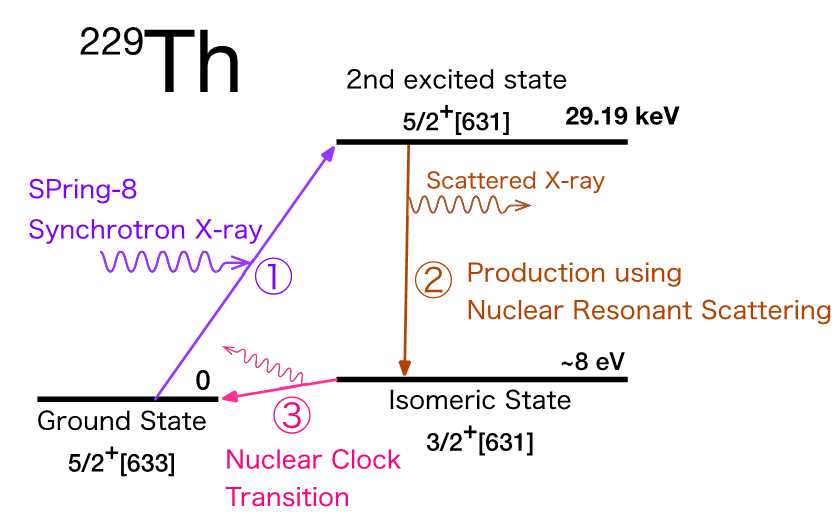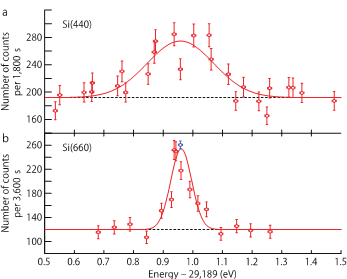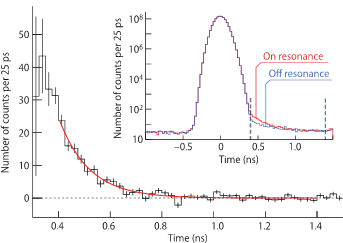The Th-229 isomer is produced in the process of order ①-②. Using the resulting isomer, a nuclear clock transition (③) would be observed.
Enlarge Image Fig. 2 Resonance curves of Th-229 NRS.
The plots showed number of events scattered by nuclei with various X-ray beam energies. Resonance peaks are clearly observed in both energy scan using different energy resolution monochromators (Si440, Si660).
Enlarge Image Fig. 3 Half life of 2nd excited state.
Inset shows the temporal profile of on resonance and off resonance data. The difference is plotted in the main plot showing the clear exponential decay with 82.2 ps half life.
Enlarge Image
Novel production method of the lowest energy nuclear state Thorium-229 nuclear clock isomer
Among thousands of nuclei, thorium-229 (Th-229) has the lowest energy excited state – so called isomer. This state is the unique nuclear state whose energy is low enough to be excited optically with laser light. Laser manipulation of the state could be utilized for an ultra-precise “nuclear clock” as well as to study fundamental physics such as time variation of physical constants.
This unique feature of Th-229 has attracted interest for over 40 years. Despite of many attempts, however, direct laser excitation has not yet achieved and its basic properties still remain elusive. One of the difficulties in the study of Th-229 is that its isomer only exists throughαdecay of uranium-233, which accompanies a complicated nuclear process with large radio activity.
Here, a research team comprising of members from Okayama University, National Institute of Advanced Industrial Science and Technology (AIST), Osaka University, Kyoto university, Tohoku university, TU Wien, RIKEN, and Japan Synchrotron have developed a novel method for producing the Th-229 isomer via the second excited state near 29 keV using X-ray beams (Fig.1). The method is based on a nuclear resonant scattering technique (NRS) using the strong synchrotron X-ray facility, SPring-8.
The research team successfully observed the NRS signal and determined the energy level and the life time of the 2nd excited state of Th-229 with unprecedented accuracy (Fig.2 and Fig.3). A large amount of Th-229 isomer, predominantly decayed from the 2nd excited state, can now be produced in a controllable manner. This new method enables the production of Th-229 isomer under clean conditions without radioactivity and is expected to push forward research on Th-229 towards the realization of a “nuclear clock”.
Reference:
- Authors: Takahiko Masuda, Akihiro Yoshimi, Akira Fujieda, Hiroyuki Fujimoto, Hiromitsu Haba, Hideaki Hara, Takahiro Hiraki, Hiroyuki Kaino, Yoshitaka Kasamatsu, Shinji Kitao, Kenji Konashi, Yuki Miyamoto, Koichi Okai, Sho Okubo, Noboru Sasao, Makoto Seto, Thorsten Schumm, Yudai Shigekawa, Kenta Suzuki, Simon Stellmer, Kenji Tamasaku, Satoshi Uetake, Makoto Watanabe, Tsukasa Watanabe, Yuki Yasuda, Atsushi Yamaguchi, Yoshitaka Yoda, Takuya Yokokita, Motohiko Yoshimura & Koji Yoshimura
- Title of original paper: X-ray pumping of the 229Th nuclear clock isomer.
- Journal: Nature volume 573, pages238–242(2019)
- Digital Object Identifier (DOI) :https://doi.org/10.1038/s41586-019-1542-3
- Journal website: https://www.nature.com/articles/s41586-019-1542-3
- Affiliations: Research Institute for Interdisciplinary Science, Okayama University, Research Institute for Interdisciplinary Science, Okayama University, National Institute of Advanced Industrial Science and Technology (AIST), RIKEN, Wako, Graduate School of Science, Osaka University, Institute for Integrated Radiation and Nuclear Science, Kyoto University, Institute for Materials Research, Tohoku University, Institute for Atomic and Subatomic Physics, TU Wien, RIKEN SPring-8 Center, Japan Synchrotron Radiation Research Institute




